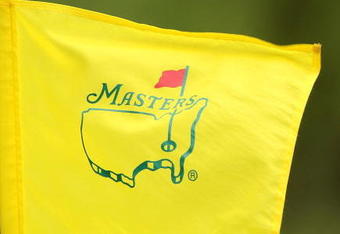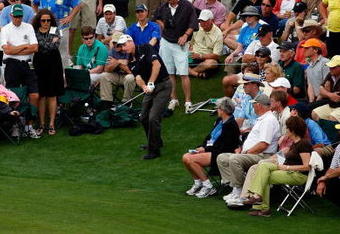No tournament has such allure, yet it is the only major played at the same course year in and year out. No course in major tournament use has Augusta National’s contours, especially on the greens, and no course has a back nine that can induce such drama.
That’s what makes us watch, but while we marvel at the drama and take in the beauty from the comfort of our living rooms, here are the 10 things about Augusta National you won’t hear on television.
1) Limited Time Only
There are about 40,000 “patrons” on course during the competition, but during the Monday, Tuesday and Wednesday practice rounds, the count swells to 50,000. And many of them congregate at the on-site building that sells shirts, hats and anything else with a Masters logo.
It is not uncommon to see people stand in line for an hour and, after shopping to the point of almost being unable to carry the merchandise to the car, returning to the tournament and standing in line again. The logo never changes, so a shirt from 2007 is going to look like a shirt from 2011, but the line hardly ever abates.
In contrast, courses that host the U.S. Open, which does change yearly, often start selling logoed merchandise months in advance, and even now you can buy a 2010 U.S. Open hat from Pebble Beach.
 The logo, seen here on a flagstick, never changes, and merchandise sales represent a huge source of income for Augusta National.
The logo, seen here on a flagstick, never changes, and merchandise sales represent a huge source of income for Augusta National.Streeter Lecka/Getty Images
During the Martha Burk “no women” controversy, Augusta National President Hootie Johnson made the statement that the club “doesn’t need TV” and the millions that come every year in fees from selling broadcast rights. Seeing the millions in memorabilia that get gobbled up by golf fans every day suggests Johnson probably is right.
2) Who’s the Member?
The Green Jacket came about for a very simple reason. In the tournament’s early years Augusta National members were encouraged to wear the jacket so patrons would know who to ask questions. Secondarily, when a member hosts guests in the clubhouse, the green jacket designates who gets the bill.
3) The Cheapest Ticket Among Premier Sporting Events.
A badge that allows you to see four competitive rounds will cost you $200—$50 per round. In contrast, Sunday’s badge for the U.S. Open last year was more than twice that.
Of course, the stories are legend about how long it takes to get a Masters pass—years. Families will them down to generation after generation.
 Augusta National likes to have its flora in full bloom during The Masters.
Augusta National likes to have its flora in full bloom during The Masters.David Cannon/Getty Images
4) Strict But Polite
They are not fans. They are not a crowd or even a gallery. They are patrons. You’ll hear it often during the CBS broadcast. Also, while on the grounds, patrons are told not to run. Walking only.
Also, watch any pro tournament and behind the golfers you’ll see a cadre of sign-bearers, reporters, photographers, broadcast personnel and cameramen. Not at Augusta. Between the ropes, competitors, caddies and rules officials only.
Patrons who show up early and place their chairs and leave will find their chairs waiting for them when they return. Try that at Bethpage Black outside New York.
More than 40 years ago, during one tense moment, CBS commentator Jack Whitaker used the term “mob” to describe the scene around a green. The Masters leadership let his bosses know that he wouldn’t be invited back, and he wasn’t.
Of course, there were Gary McCord’s famous lines about “bikini waxes” and “body bags.” It’s been 17 years. He hasn’t been back, either.
5) 1980 Prices
 Put your chair down in the front row, and then leave it for a few hours? It will still be there when you come back.
Put your chair down in the front row, and then leave it for a few hours? It will still be there when you come back.Jamie Squire/Getty Images
It used to be pimento cheese sandwiches, but now there’s bbq, chicken and others—each for about $3. A beer costs under $3. That’s right—a beer and a sandwich at a major sporting event costs $6. This in an age when a watery light beer in a plastic cup at the ballpark costs $8.
6) Icing the Azaleas
Augusta, Georgia is one of the few places that Sunset Magazine designated a “garden spot,” meaning there you could throw a seed in the ground and six weeks later you’ll harvest something.
In that vein, the site founder Bobby Jones selected was a nursery, so the flora is amazing, to say the least. But Augusta National does it to extremes.
If an early spring comes, grounds crew will put ice under the azaleas to slow down their blossoming. They want everything in full color come Masters week. (Note: They cannot control rain, however. Yet.)
7) Over-The-Top Maintenance
It’s the smallest major field—only 99 competitors compared to the 156 in the other three majors. Following the second round, the low 44 scores, plus ties and any golfer within 10 strokes of the lead advance to play the on the weekend.
 No course has the maintenance resources of Augusta National.
No course has the maintenance resources of Augusta National.David Cannon/Getty Images
That means for Saturday and Sunday the field will be anywhere from 44 to 55. Get there early enough you will find more than 60 people working on the course, mowing, raking, edging, etc.
(Of note, there are many who think this does the golf industry a disservice by showing a course so luxurious, verdant and immaculate. It’s a standard that any other course cannot meet, much less your local muni. But then, there’s no other course in the America that has the resources of Augusta National when it comes to maintenance.)
8) Limited Time (Part II)
Augusta National may not be the best course in terms of golf in the country. But it’s definitely the most remodeled course ever. Bar none.
Augusta National closes in late spring and doesn’t open again until fall. Part of this stems from its origins in the mid-1930s. Jones wanted it to be a “national” club, meaning members live all over the country to play. For business executives from the Northeast, the winter was the best time to play.
During that no-play period during the summer, Augusta National undertakes projects to improve the course, which is why you get the following scene:
 Tweaking the 15th green, and just about every other part of the course, is an annual rite at Augusta National.
Tweaking the 15th green, and just about every other part of the course, is an annual rite at Augusta National.David Cannon/Getty Images
Sunday morning, early, final round of the Masters.
Patron behind the 15th green, watching a CBS broadcaster practice some putts on the green to learn their breaks (the earliest competitors were just starting on No. 1.)
“How are the greens,” someone asked.
“Great,” said broadcaster.
“No, really, how are the greens?”
With that, the broadcaster looked around to make sure his comments were not overheard. They went something like this: “This club changes something in this course every year, and they never tell you about it.”
9) Value
It’s one of the best-kept numbers in sports—the initiation fee to Augusta National. With barons like Warren Buffett and Bill Gates, among others, as members it goes without saying that money isn’t the object. And it isn’t. To join is reportedly under $100,000, which might be one-tenth of other high profile clubs in the country.
And if you were lucky enough to play the course with member, you can probably afford it. Guest fees are said to be about $40.
 All the idiosyncracies of Augusta National make putting on the Green Jacket all the more rewarding.
All the idiosyncracies of Augusta National make putting on the Green Jacket all the more rewarding.Harry How/Getty Images
10) The Bill
The story came from an Augustan resident who also works in the town and has played Augusta more than a few times. His experience has been verified by others who had the same thing happen to them. It goes like this:
You’re there for business golf. You meet in the clubhouse for dinner the night before. Coat and tie. Wine is ordered. The food is superb, and so is the wine. So you order another bottle. Then another.
Next day, to the course. Great time. Lunch. Perhaps another round. Then dinner. More great food and great wine. Maybe a couple of bottles. Next day everyone departs.
A week later you get an email: “OK, time to sober up and pay up.” And it’s not uncommon to find that you owe $3,000, and it’s not for the golf (see above). Those bottles of wine are the culprit.
Augusta National is presumed to have one of the best private wine cellars in the world, buying the best French, Italian, American and Australian wines on futures. Those glasses of wine that tasted so good during dinner came from bottles that run $1,000 apiece, and more.
And yet they say it’s all worth it.
No comments:
Post a Comment
Note: Only a member of this blog may post a comment.